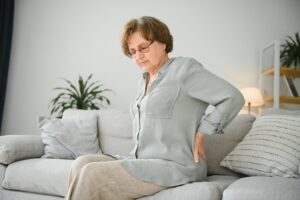 A recent study from the University of Turku in Finland revealed that reducing the amount of time spent sitting each day can help prevent back pain from worsening over six months. This finding supports the existing knowledge about how staying active can impact back pain and sheds more light on what happens in the body that might lead to back pain.
A recent study from the University of Turku in Finland revealed that reducing the amount of time spent sitting each day can help prevent back pain from worsening over six months. This finding supports the existing knowledge about how staying active can impact back pain and sheds more light on what happens in the body that might lead to back pain.
It might seem obvious that sitting less could help with back pain, but surprisingly, there has been little research to prove this theory. This new study, conducted by the Turku PET Centre and the UKK Institute in Finland, specifically looked at whether reducing sitting time could help overweight or obese adults who spend most of their day sitting.
Advertisement
The participants in the study managed to cut their sitting time by an average of 40 minutes per day over the six months of the study. These individuals were generally middle-aged adults who led sedentary lives, rarely exercised, and had gained some extra weight. These factors, such as sitting for long periods, not being physically active, and being overweight, increase the risk of both heart disease and back pain.
In previous research, it has been suggested that sitting for too long could be harmful to the back, but the data has been limited. This study aimed to explore whether there was a direct link between reducing sitting time and preventing back pain.
In addition to looking at sitting time, the researchers also examined what might be happening in the body that could cause or prevent back pain. They used advanced methods, including magnetic resonance imaging (MRI) and positron emission tomography (PET) scans, to closely study the back muscles of the participants. These scans helped the researchers measure the fat levels in the back muscles and examine how well the body processed glucose (a type of sugar) in those muscles.
Even though the researchers did not find a clear connection between improvements in back pain and changes in the muscle’s fat levels or glucose metabolism, they still found that reducing sitting could help with back pain. People with back pain often have higher fat deposits in their back muscles and poor glucose metabolism, which can increase the risk of pain. However, the study suggested that back pain relief can still occur even if no noticeable change exists in these muscle conditions.
The researchers pointed out that reducing sitting time could be helpful for people who are concerned about their back health. They encouraged individuals who sit for long periods to try and find ways to decrease sitting, whether at work or during free time. Still, they stressed that simply standing up is not enough—engaging in physical activities such as walking or more intense exercise is more beneficial.
In conclusion, the researchers emphasized that changing postures regularly throughout the day is more important than focusing on maintaining a “perfect” posture. Shifting positions and staying active can reduce the risk of back pain and improve overall back health, even without making drastic changes to muscle composition or metabolism.
